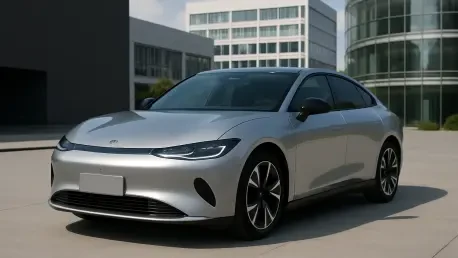In a fascinating turn of events within the rapidly evolving electric vehicle (EV) landscape, Xiaomi, a Chinese smartphone powerhouse, has emerged as a surprising victor with its innovative SU7 model, while Apple, a global tech behemoth, has abandoned its ambitious Project Titan after a decade of effort and a staggering $10 billion investment with little to show for it. This stark contrast in outcomes raises compelling questions about what drives success in an industry that blends cutting-edge technology with deep consumer engagement. The EV market has transformed into a complex arena where manufacturing prowess alone isn’t enough; it demands strategic alignment, supply chain mastery, and an ability to resonate with buyers on a personal level. Exploring the factors behind Xiaomi’s achievements and Apple’s setbacks offers a window into the broader shifts reshaping the automotive sector, revealing lessons that could redefine competition for years to come.
The disparity between these two tech giants underscores the unique challenges and opportunities within the EV space. Xiaomi’s swift ascent suggests a formula that capitalizes on regional advantages and consumer trends, while Apple’s retreat highlights the pitfalls even the most resource-rich companies can face when venturing into unfamiliar territory. From government policies to brand loyalty, the dynamics at play are intricate and multifaceted. This narrative extends beyond just two companies, reflecting a pivotal moment in how technology and mobility intersect in today’s global market.
The Power of Supply Chain and Regional Advantages
China’s EV Ecosystem as a Launchpad
China’s dominance in the EV supply chain has proven to be a critical asset for companies like Xiaomi, providing a robust foundation that Apple struggled to replicate. With industry leaders such as BYD and CATL controlling significant shares of battery and component production, Xiaomi gained access to high-quality materials at competitive costs, enabling rapid development of the SU7. This infrastructure, built over years of focused investment, allows Chinese firms to scale operations efficiently, shaving off time and expenses that competitors outside this ecosystem often grapple with. Government subsidies further amplify this advantage, creating an environment where innovation and production can thrive without the financial burdens that might stifle progress elsewhere. For Xiaomi, this meant a smoother path from concept to market, positioning it as a formidable player almost overnight in a field where timing is everything.
Beyond mere access to resources, China’s EV ecosystem fosters a collaborative network that accelerates problem-solving and adaptation. Policies encouraging domestic manufacturing have cultivated a dense web of suppliers and expertise, which Xiaomi tapped into with ease to refine its vehicle design and production processes. In contrast, Apple, operating largely outside this sphere, likely encountered steeper hurdles in sourcing components or building comparable partnerships. This regional disparity isn’t just about cost—it’s about speed and agility in responding to market demands. While China’s system isn’t without criticism for its labor practices, the undeniable edge it provides in efficiency and scale highlights why companies rooted in this environment often outpace global rivals. Xiaomi’s ability to harness these systemic benefits underscores a broader lesson for the industry: location and policy can be as decisive as innovation itself.
Government Support and Structural Edge
Government backing in China has played a pivotal role in shaping the success of domestic EV manufacturers like Xiaomi, creating a structural advantage that’s hard to match. Subsidies and incentives have fueled the growth of an entire supply chain, from raw materials to finished vehicles, allowing companies to invest heavily in research and production without immediate financial strain. This support has positioned China as a global leader in EV technology, with firms like Xiaomi benefiting from reduced barriers to entry. Unlike Apple, which faced a more fragmented and less subsidized environment in other regions, Xiaomi could lean on a state-driven framework that prioritizes industry growth. This policy landscape has not only lowered costs but also encouraged rapid innovation, giving Chinese automakers a head start in a competitive race.
Critics often point to ethical concerns surrounding China’s industrial practices, such as labor conditions, but it’s worth noting that historical subsidies in other nations, like environmental cost oversights in the U.S., have also shaped industries in different ways. The key difference lies in execution—China’s consistent focus on EV development contrasts with inconsistent global approaches that leave companies like Apple navigating a patchwork of regulations and support. For Xiaomi, this meant a clearer path to market dominance within its home territory. The structural edge provided by such policies isn’t merely financial; it builds a cohesive ecosystem where every link in the chain, from mining to assembly, aligns toward a common goal. This alignment has proven to be a game-changer, illustrating how national strategy can amplify corporate success in specialized sectors like EV manufacturing.
Consumer-Centric Innovation and Brand Strength
Ecosystem Integration and Emotional Bonding
Xiaomi’s approach to the EV market stands out for its seamless integration of the SU7 into a broader ecosystem of consumer electronics, a strategy that Apple failed to mirror effectively. By using the same operating system across devices—from smart vacuums to air conditioners—the SU7 becomes more than a vehicle; it’s a connected hub that syncs with users’ daily lives. Features like optimized charging based on personal routines, accessible through an app store from the first day of ownership, showcase a deep understanding of tech-savvy consumers’ needs. This connectivity transforms the car into an extension of Xiaomi’s digital universe, offering convenience and personalization that resonate in a market hungry for innovation. Such integration not only enhances functionality but also builds a sense of familiarity, making the SU7 feel like a natural addition to a customer’s tech arsenal.
Equally significant is Xiaomi’s ability to forge an emotional connection with its audience, a factor often overlooked in tech-driven industries. Building on its established brand loyalty in China’s consumer electronics space, Xiaomi instilled trust and excitement around the SU7, tapping into the principle that purchases are driven by emotion before logic. This bond, cultivated over years through affordable, user-friendly products, gave Xiaomi an edge in a market where personal attachment to a brand can sway decisions. Apple, despite its global reputation, couldn’t replicate this visceral appeal in the EV realm, possibly due to treating the project as a detached venture rather than a heartfelt extension of its identity. Xiaomi’s knack for blending emotional resonance with practical innovation highlights a critical driver of its success, setting a benchmark for how consumer engagement can redefine market entry.
Adapting to Local Preferences and Market Savvy
Xiaomi’s deep understanding of Chinese consumer preferences allowed it to tailor the SU7 in ways that hit the mark culturally and practically, an area where Apple’s approach seemed less attuned. From design elements to pricing strategies, Xiaomi crafted a product that aligns with local tastes, emphasizing affordability without sacrificing cutting-edge features. This market savvy reflects years of experience catering to a price-sensitive yet tech-hungry demographic, ensuring the SU7 wasn’t perceived as an out-of-reach luxury but as an accessible status symbol. Such alignment with consumer expectations created immediate buzz and demand, propelling Xiaomi ahead in a densely competitive domestic landscape where understanding the buyer’s mindset is half the battle.
Furthermore, Xiaomi’s agility in adapting to feedback and iterating quickly on its offerings contrasts sharply with the slower, more isolated development cycle Apple appeared to follow. By embedding itself within the daily digital interactions of its users through apps and interconnected devices, Xiaomi could gather real-time insights to refine the SU7’s appeal. This responsiveness not only strengthened its foothold in China but also built a foundation of loyalty that’s hard to shake. Apple’s failure to similarly engage with potential EV buyers, perhaps due to a lack of localized focus or direct consumer dialogue in this sector, left it disconnected from the very market it aimed to penetrate. Xiaomi’s success in this regard underscores the value of cultural resonance and adaptability as cornerstones of breaking into new industries.
Strategic Missteps and Market Challenges
Apple’s Isolated Approach
Apple’s ambitious Project Titan, despite a monumental investment, stumbled due to a lack of integration with its broader technological ecosystem, a misstep that Xiaomi avoided with finesse. Unlike Xiaomi’s SU7, which operates as a seamless part of a connected device network, Apple treated its EV initiative as a standalone endeavor, failing to leverage the synergy that defines its other products. This isolation likely diminished the project’s appeal, as it couldn’t offer the same cohesive user experience that customers expect from the brand. Without embedding the car into a familiar digital framework, Apple missed an opportunity to create a compelling narrative around its vehicle, leaving potential buyers without a clear reason to embrace it over established alternatives in a fiercely competitive space.
Additionally, supply chain challenges outside China’s well-oiled EV infrastructure likely compounded Apple’s struggles, highlighting a critical strategic oversight. Lacking access to the cost-effective, rapid-response networks that Xiaomi utilized, Apple faced higher barriers in sourcing components and scaling production. This logistical disadvantage, paired with an apparent inability to build an emotional connection with consumers, left Project Titan vulnerable. While Apple excels in controlled, premium markets, the EV industry demands a different kind of agility and partnership—one that adapts to external ecosystems rather than dictating terms. The failure to pivot toward a more collaborative or regionally aligned strategy reveals how even giants can falter when entering uncharted territory without a fully integrated vision.
Underestimating Emotional and Cultural Factors
Another layer to Apple’s setback lies in its underestimation of the emotional drivers that influence car purchases, a domain where Xiaomi excelled by leveraging brand familiarity. Vehicles are not just functional items; they carry personal and cultural significance, often tied to identity and aspiration. Apple, despite its mastery in creating desire for gadgets, couldn’t translate that allure into the automotive space, possibly because it lacked a narrative that resonated on a deeper level with potential buyers. Without a story or connection that made the EV feel personal, the project remained a cold, technical exercise, failing to ignite the passion needed to compete in a market driven by sentiment as much as specs.
Compounding this was Apple’s apparent disconnect from the cultural nuances of key EV markets, particularly in regions like China where local pride and tailored offerings hold sway. Xiaomi capitalized on these elements, embedding the SU7 with features and branding that felt distinctly relevant to its core audience. Apple, by contrast, may have approached the market with a one-size-fits-all mindset, a strategy ill-suited to an industry where regional tastes and loyalties heavily influence success. This oversight, alongside structural challenges, paints a picture of a company that, while innovative in many arenas, couldn’t adapt its playbook to the unique demands of EV consumer engagement, ultimately leading to Project Titan’s demise.
Industry Trends and Global Implications
Tech-Driven Transformation and International Ambitions
The EV market is undergoing a profound transformation, shifting toward a tech-centric model where software integration and consumer engagement are as vital as hardware, a trend Xiaomi embodies with striking clarity. By prioritizing rapid development cycles and embedding the SU7 within a network of connected devices, Xiaomi has outmaneuvered traditional automakers still adapting to this digital pivot. Success in today’s landscape requires viewing vehicles not as isolated products but as components of a broader ecosystem—a lesson Apple missed in its EV endeavor. This evolution signals a future where tech companies, not just car manufacturers, could dominate, reshaping competition in ways that demand agility and foresight from all players in the field.
Looking ahead, Xiaomi’s potential to expand internationally hints at a new wave of challenges for global automakers, driven by China’s intense domestic competition. With excess production capacity pushing Chinese firms to seek export markets, Xiaomi’s blend of innovation and brand strength positions it as a formidable contender overseas. This ambition to go global isn’t just about volume; it’s about redefining how vehicles are perceived through a tech-first lens, potentially altering consumer expectations worldwide. As this trend unfolds, established manufacturers and other tech giants must reckon with the possibility that companies like Xiaomi could disrupt long-standing hierarchies, forcing a reevaluation of strategies to stay relevant in an increasingly interconnected market.
Lessons for Future EV Contenders
Reflecting on the contrasting paths of Xiaomi and Apple offers valuable insights for future entrants into the EV arena, particularly around the need for holistic strategies. Xiaomi’s triumph stemmed from blending supply chain access, consumer-focused innovation, and emotional branding into a unified approach, proving that fragmented efforts often fall short. Companies aiming to break into this space must prioritize partnerships and regional advantages, ensuring they’re not isolated from the ecosystems that drive efficiency and scale. This means looking beyond internal capabilities to build networks that support rapid, cost-effective production and market entry, a critical takeaway from China’s model.
Moreover, the importance of cultural resonance and consumer connection cannot be overstated for those eyeing the EV market in the coming years. Apple’s stumble highlighted the risk of neglecting the human element in a sector where purchases are deeply personal. Future contenders should invest in understanding local values and weaving those into their offerings, much like Xiaomi did with the SU7. As the industry continues to evolve, success will hinge on marrying technological prowess with emotional storytelling, creating products that don’t just perform but also inspire. These lessons, drawn from past outcomes, pave the way for smarter approaches, ensuring new players can navigate the complexities of this dynamic field with greater confidence.









